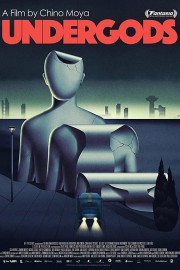Undergods (Fantasia Fest)
**Watched for the 2020 Fantasia International Film Festival.
The structure of “Undergods” is kind of surreal. Chino Moya’s screenplay is elliptical in nature, and seems to draw from the idea of anthology storytelling. And yet, there are stories that take place that feel as though they are happening in real time with the events that start the film. That might make the film a bit of a confounding one for audiences, but the stories being told are interesting, and the world they take place in is a haunting one.
We begin in a fog. A man in walking the streets alone. At first, he looks quite tall, but then, a truck comes up next to him, and we see he is average size. The two men driving the truck- K (Johann Myers) and Z (Géza Röhrig) look like trash collectors, roaming the streets. It is not a garbage truck they are driving, however, although they do pick up things along the side of the road; people, to be specific, and they go in the back of the truck, where many more bodies are kept. While driving, they talk about their dreams, and stories they’ve heard, and that’s where the film becomes an anthology.
I’m of very mixed mind about the world of “Undergods.” On the one hand, I love the desolate vision Moya conjures with her cinematographer, David Raedeker, and how it is enhanced by the synthesizer score from composer Wojciech Golczewski, which will conjure musical memories of “Mandy” and “Color Out of Space,” as well as several ’80s films. This is a beautiful, ugly film to watch, and I could live in it all day. On the other hand, we are given no real indication of why the world is what it is. Is it after an apocalyptic war? Starvation? A plague? We don’t really get a feel for what is going on in this world, and we are to just accept it. The first story, involving a couple set upon by a houseguest, is set in an apartment building where no one else is currently living. We can work out that one just fine, but later stories involve what seems to be forced labor and psychological help in the form of a cult, so our sense of the world feels jumbled. But honestly? I still really enjoyed diving into this world. It’s still compelling, and that’s what matters.
There are three primary stories we are told here, and several that start, or finish, at other ones, and K and Z seemingly at the heart of it all. The pair telling each other about their dreams is what leads us into the story in the apartment building, which leads to a father and daughter, who move into that building, and him telling her a weird story about a father and daughter, where the daughter goes missing. And that story leads to more of K and Z, and the true nature of their business, before we culminate, once again, with a husband and wife beset by an unusual visitor- in this case, it’s the wife’s ex-husband, who disappeared 15 years ago. We become engrossed with each of these stories, which do carry with them a sense of isolation and desperation that is a common thread throughout the film. Even though we don’t know what led to the world being the way it is in “Undergods,” the sense of trying to make sense of it, and struggling to do so, is something shared with the characters. This is not a film you watch for entertainment purposes, although there are some dark laughs to be had, but to reflect on our world through a reflection of how it feels, which is what Moya has done so effectively here.










